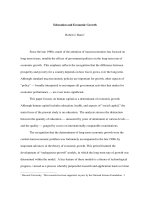Air Education and Training Command Cost and Capacity System: Implications for Organizational and Data Flow Changes ppt
Bạn đang xem bản rút gọn của tài liệu. Xem và tải ngay bản đầy đủ của tài liệu tại đây (764.97 KB, 120 trang )
Project AIR FORCE
R
Prepared for the
UNITED STATES AIR FORCE
Approved for public release; distribution unlimited
Thomas Manacapilli
Bart Bennett
Lionel Galway
Joshua Weed
AIR EDUCATION
AND
TRAINING
COMMAND C
OST
AND
CAPACITY
SYSTEM
Implications for Organizational
and Data Flow Changes
The RAND Corporation is a nonprofit research organization providing
objective analysis and effective solutions that address the challenges
facing the public and private sectors around the world. RAND’s
publications do not necessarily reflect the opinions of its research clients
and sponsors.
R
®
is a registered trademark.
© Copyright 2004 RAND Corporation
All rights reserved. No part of this book may be reproduced in any form
by any electronic or mechanical means (including photocopying,
recording, or information storage and retrieval) without permission in
writing from RAND.
Published 2004 by the RAND Corporation
1700 Main Street, P.O. Box 2138, Santa Monica, CA 90407-2138
1200 South Hayes Street, Arlington, VA 22202-5050
201 North Craig Street, Suite 202, Pittsburgh, PA 15213-1516
RAND URL: />To order RAND documents or to obtain additional information, contact
Distribution Services: Telephone: (310) 451-7002;
Fax: (310) 451-6915; Email:
Library of Congress Cataloging-in-Publication Data
Air Education and Training Command cost and capacity system : implications for
organizational and data flow changes / Thomas Manacapilli [et al.].
p. cm.
Includes bibliographical references.
“MR-1797.”
ISBN 0-8330-3503-7 (pbk. : alk. paper)
1. United States. Air Force. Air Education and Training Command—Evaluation.
2. Aeronautics, Military—Study and teaching—United States—Evaluation. I.
Manacapilli, Thomas.
UG638 .A65 2003
358.4'15'0684—dc22
2003024475
The research reported here was sponsored by the United States Air Force
under Contract F49642-01-C-0003. Further information may
be obtained from the Strategic Planning Division, Directorate of
Plans, Hq USAF.
iii
PREFACE
The goal of this study was to help establish the strategic design for a
comprehensive system to assess and manage the cost and capacity of
the Air Force’s pipeline for enlisted technical training. The study
team concluded that such a system is useful only insofar as it sup-
ports the decision processes necessary for managing effective train-
ing. Therefore, this report examines training management and deci-
sion processes to determine the need for data to support informed
decisionmaking. It briefly reviews training management systems and
associated organizational arrangements in the other services and the
private sector to draw insights for a model management system for
the Air Force. The study identifies impediments to training planning
and management in the current Air Force organizational structure
that inhibit the flow of cost and capacity data and hinder effective
decisionmaking. It also outlines analytic developments that could
help convert raw data into information useful for decisionmakers.
The research reported here was sponsored by the Air Education and
Training Command (AETC/CV) and HQ Air Force Deputy Chief of
Staff, Personnel (AF/DP) and conducted within the Manpower, Per-
sonnel, and Training Program of RAND Project AIR FORCE (PAF) at
the RAND Corporation. Earlier, PAF explored the requirements of a
technical training schoolhouse model to address pipeline capacity.
By explicitly capturing resource limitations and uncertainty, the
study team anticipated that this simulation tool could assist AETC in
making difficult allocation decisions. In part, the current report
confirms the need for such tools and the roles they might play.
iv AETC Cost and Capacity System
This report should be of interest to leaders and staffs concerned with
planning and managing the Air Force’s technical training pipeline,
including AETC organizations, HQ 2AF, and the training wings and
squadrons down to the individual course level. The study reflects
feedback from this Air Force community. This report covers the time
period of October 2001 to September 2002. Please direct questions,
suggestions, or other feedback to the lead author at manacapi@
rand.org.
RAND Project AIR FORCE
RAND Project AIR FORCE (PAF), a division of the RAND Corporation,
is the U.S. Air Force’s federally funded research and development
center for studies and analyses. PAF provides the Air Force with
independent analyses of policy alternatives affecting the
development, employment, combat readiness, and support of
current and future aerospace forces. Research is performed in four
programs: Aerospace Force Development; Manpower, Personnel,
and Training; Resource Management; and Strategy and Doctrine.
Additional information about PAF is available on our Web site at
/>v
CONTENTS
Preface iii
Figures ix
Tables xi
Summary xiii
Acknowledgments xv
Acronyms and Initialisms xvii
Chapter One
INTRODUCTION 1
Information and Strategic Management of Air Force
Training 2
Implementing Enhanced Strategic Training
Management 3
Project Evolution, Methodology, and Limitations 5
Vision for Effective Strategic Training Management 7
Applying the Vision 7
Relationship of Trained Personnel Requirements to
the Vision 9
Report Structure 10
Chapter Two
MODEL TRAINING MANAGEMENT STRUCTURE AND
ASSOCIATED INFORMATION NEEDS AND FLOWS 13
Training in the Army, Navy, and Selected Commercial
Firms 14
Lesson 1: Consolidate Management Functions 15
Lesson 2: Reduce Organizational Layering 15
vi AETC Cost and Capacity System
Lesson 3: Derive Training Requirements from
the User Community 16
Lesson 4: Span of Control Should Not Be a Big
Concern 16
Model Management Structure for Training 17
Corporate Level 18
Strategic Training Management Level 19
Training Management Level 20
Direct Training Level 21
Users and Training Infrastructure 21
Information Needs and Flows by Type and Level 22
AETC Management Information Needs and Flows 23
Cost Information Data Needs and Flows 23
Capacity Information Data Needs and Flows 26
Quantity Information Data Needs and Flows 28
Quality Information Data Needs and Flows 29
Summary 31
Chapter Three
CURRENT AETC TRAINING MANAGEMENT STRUCTURE
AND DATA FLOWS 33
Current AETC Management Structure 33
Data Flow Deficiency Analysis 37
Cost Data Flow Deficiencies 38
Capacity Data Flow Deficiencies 44
Quantity Data Flow Deficiencies 48
Quality Data Flow Deficiencies 50
Deficiency Summary 51
Need for Real-Time Data 53
Conclusions 54
Chapter Four
FINDINGS AND FUTURE WORK 55
Findings 56
Importance of Training Management 56
Availability of Cost Data 57
Accessibility of Cost, Capacity, Quantity, and Quality
Data 58
Organization of Strategic Training Management 58
Future Work 60
A Technical Training Schoolhouse Model 61
Contents vii
An End-to-End Training Model 61
Applying Capital Costs to Courses and Students 64
Appendix
A. Literature Review and Case Studies 67
B. Methodological Considerations 89
Bibliography 97
ix
FIGURES
1.1. Sustaining Combat Capability with Ready
Personnel and Ready Equipment 8
1.2. Training-Related Tradeoffs in Sustaining Combat
Capability 9
2.1. Four Broad Functional Levels in the Training
Process 18
2.2. Cost Data Flow 25
2.3. Capacity Data Flow 27
2.4. Quantity Data Flow 28
2.5. Quality Data Flow 31
3.1. Distribution of Technical Training Functions
Among Organizations 34
3.2. Cost Information Data Deficiency Ratings 39
3.3. Capacity Information Data Deficiency Ratings 44
3.4. Quantity Information Data Deficiency Ratings 48
3.5. Quality Information Data Deficiency Ratings 50
3.6. Summary of Deficiencies by Data Type and
Organizational Level 52
4.1. Technical Training Schoolhouse Model 62
4.2. End-to-End Model Schematic 63
A.1. AFMC Organizational Structure 76
A.2. Idealized Army Training Structure 77
A.3. Simplified Functional Organizational Chart for
Army’s Signal Center and Fort Gordon 79
xi
TABLES
2.1. Technical Training Functions for Each Training
Management Level 19
3.1. O&M Costs for Direct Training (Inside the
Classroom), Including Direct Training Support 39
3.2. Pay and Allowance Costs for Direct Training, Course
Development, Evaluations, Course Administration,
and Strategic Training Management 41
3.3. Training Facilities and Base Operating Support
Costs 42
B.1. Simple Example of Costing an AFSC 91
xiii
SUMMARY
The mission statement of the Air Education and Training Command
(AETC)—“recruiting, training, and educating professional airmen to
sustain the combat capability of America’s Air Force”—provides a
good starting point for developing information requirements for
training management. Combat capability is directly affected by the
quantity and quality of trained personnel. And the provision of suf-
ficiently trained Air Force personnel relies upon effective manage-
ment of training production and, in turn, the cost and capacity of the
training system. Arguably, AETC currently has difficulty assembling
and using cost and capacity data in managing its training pipeline,
particularly for technical training. We find that this is partly due to
an organizational structure that is both too complex and too unclear
and has overlapping decisionmaking responsibilities.
We developed a four-level model of management to evaluate the flow
of data in the AETC training pipeline:
1. The corporate level validates and arbitrates training requirements.
(See p. 18.)
2. The strategic training management level concentrates on the
training system’s long-term effectiveness. (See p. 19.)
3. The training management level handles the day-to-day operations
of training. (See p. 20.)
4. The direct training level delivers training in the classrooms.
(See p. 21.)
xiv AETC Cost and Capacity System
Most data needed for informed decisionmaking in AETC exist at the
bottom two levels but often do not flow adequately to the top two
levels. Part of the problem is that strategic training management is
split among multiple organizations: no central organization has the
manpower to work capacity issues (e.g., addressing surge or limiting
constraints), reduce Trained Personnel Requirements (TPR) short-
falls, evaluate quality information, develop cost methodologies for
planning, and serve as the single advocate for technical training
in the Air Force. As a result, data flow among training management
organizations is ad hoc. (See pp. 33–53.)
We looked at how strategic training management was handled in
other training organizations to help motivate our model and provide
lessons for AETC. The Army has organized strategic training man-
agement at the functional level, with no intervening organizations
between it and training management. Currently, the Navy has a very
decentralized training operation but is conducting an extensive revi-
sion effort to correct disconnects discovered during its Executive
Review of Naval Training. Our case studies of four major companies
with large training programs show that although these companies
employ different organizational designs, all have a clearly defined
senior person responsible for organizing training and making strate-
gic decisions. (See pp. 14ff.)
We recommend organizational and process changes at the strategic
training management level (mostly residing in HQ AETC). We be-
lieve that a consolidation of the strategic management functions,
within an organization probably headed by a two-star general,
would, among other things, resolve many current data flow prob-
lems. We also recommend that methodological tools be developed,
including simulations to evaluate tradeoffs in the training pipeline,
in order to improve data combination and interpretation, particu-
larly in the area of cost. It is also clear that AETC should have a cen-
tral data “warehouse” for collecting cost and capacity data. We be-
lieve that a “real-time” minute-by-minute data tracking system is not
warranted and would not be cost-effective. Finally, we recommend
that cost and capacity data be fit into the AETC Decision Support
System/Technical Training Management System (ADSS/TTMS) ar-
chitecture already under development for training production data.
(See pp. 56–60.)
xv
ACKNOWLEDGMENTS
A number of people contributed to this research. We acknowledge
them in a somewhat chronological order.
We began with a schematic of the training process that Al Robbert,
1
a
former AF/DP division chief, developed. This schematic was a very
helpful guide for our discussions with the offices we visited.
We thank all at HQ AETC who helped us, whom we list here by office:
XP (Col Mike Snedeker, Jack Wilder, Meg Salvadore, Jerry Aho, Gary
Beitzel, Dan Goetz, Ruth Lease, Capt Bill Crooks, Larry Hughes, Capt
Courcy, Richard Carroll, Woody Roberts, Bill Friday, Marybeth
Coffer); DO (Robby Robinson, Lt Col Eddie Billman, Tom Gates, Joe
Pollock); FM (Pam Struzyk, Cherlyn Koehler, Mark Parsons, Richard
Hutchins); CE (Maj Jon D’Andrea, Chuck Miller, Al Ennis, Charles
Lasley, Susan Higgins); and RS (MSgt Ed Heinbaugh, Capt James
Feldhaus). Our visit to BMT (Lt Col Ada Conlan and the staff of the
319th Classification Squadron) was also of great help.
At the Air Staff we received similar assistance from XP (Capt
Guillermo Palos); DP (Col Nancy Weaver, Lt Col Tony Henderson, Lt
Col May, Maurice Lang, Col Linda Cunningham, Ken Spires, Capt Joe
Cloeter); and AFPOA (Maj Steve Forsythe, Maj Matt Santoni).
Second Air Force, the Keesler AFB training wing, the training group,
and the training squadrons were very supportive, and we are grateful
______________
1
A. Robbert et al., “Determining Course Content for Air Force Enlisted Initial Skill
Training: How Can the System Be Made More Responsive?” RAND Corporation, Santa
Monica, CA, internal draft, Jul 2001.
xvi AETC Cost and Capacity System
for first-class treatment from HQ 2AF (Maj Gen John Regni, D. W.
Selman, Sherry Hernandez, Mary Hancock, Col Jim Cropper, Gary
Peterson); 81st Training Wing (Brig Gen Mercer, Col J. B. Murray);
81st TRG (Col Fossen, Lt Col Howard Triebold); 81st TRSS (Lt Col
Glenda Reichler); 332nd TRS (Lt Col Jackson and his staff); and the
338th TRS (Maj Reese and his staff).
Additionally, we met with retired and former senior personnel with
tours in Personnel and in Training. These conversations helped us to
understand the evolution in the training organization and process.
We thank Jay Tartell, and we thank Gary Teer for providing consider-
able historical perspective on changes in AETC.
We also thank AETC/HO for tremendous support. The History Office
is a gold mine of material.
Also, we appreciate CDR Anthony Cooper and his staff at CNET PAO
for their help in understanding the Navy and its recent efforts in the
area of training management.
In industry, we wish to thank Shawn Clark, Director of Technical
Training, Northwest Airlines; Ed Bales, Motorola University; Keith
Hertzenberg, Vice President and General Manager of Training Sys-
tems and Services at Boeing Integrated Defensive Systems, Aircraft
and Missiles; Keith Jostes, Manager of Technical Training, Boeing;
and Sherman Jaffe, Senior Manager of Training Management and
Certification.
Our special thanks go to Brig Gen (Ret.) Karen Rankin and RAND
colleague Georges Vernez for their thoughtful reviews of the draft
report.
Most of all, we thank Lt Col Jim Boyd for his tireless help and support.
He set up all our trips and turned around our requests in record time.
xvii
ACRONYMS AND INITIALISMS
2AF Second Air Force
ADO assistant deputy of operations
ADSS AETC Decision Support System
AETC Air Education and Training Command
AETMS AETC Training Management System
AFMC Air Force Materiel Command
AFSC Air Force Specialty Code
AFTMS Air Force Training Management System
AMU Automobile Manufacturing University
BMT basic military training
BOS base operating support
BST business support team
BX base exchange
CBT computer-based training
CFETP Career Field Education and Training Plan
CFM career field manager
CINCPACFLT Commander in Chief, Pacific Fleet
CNET Chief of Naval Training
COSMOD Cost Modeling System
xviii AETC Cost and Capacity System
CRE course resource estimate
DEP Delayed Entry Program
DoD Department of Defense
DPG Defense Planning Guidance
DPL Deputy Chief of Staff for Personnel, Learning
DPR Director of Personnel Resources
DSS decision support system
EIS Enlisted Initial Skills
ERNT Executive Review of Naval Training
ERP enterprise resource planning
FEQ Field Evaluation Questionnaire
FI field interview
FY fiscal year
GAS Graduate Assessment Survey
GTEP Guaranteed Training Enlistment Program
HQ Headquarters
ICW interactive courseware
IIT ineffective in training
MAJCOM major command
MILCON military construction
MILPDS Military Personnel Data System
MRT mission ready technician
MU Motorola University
NAF Numbered Air Force
NCO noncommissioned officer
NW Northwest Airlines
O&M Operations and Maintenance
Acronyms and Initialisms xix
O&S Operations and Support
OJT on-the-job training
OMS Occupational Measurement Squadron
OPNAV HQ U.S. Navy Staff
OPTEMPO operating tempo
OSD Office of the Secretary of Defense
PGL Program Guidance Letter
POI plans of instruction
POL petroleum, oil, lubricants
POM Program Objective Memorandum
QOL quality of life
ROI return on investment
SAT student awaiting training
SC&FG Signal Center and Fort Gordon
SME subject matter expert
SOT student out of training
Stan/Eval Standards/Evaluation
STS Specialty Training Standard
TCO total cost of ownership
TD training device
TDS Training Decisions System
TIDES Training Impact Decision System
TPR Trained Personnel Requirements or
Training Program Requirements
TPS Training Planning System
TRADOC Training and Doctrine Command
TRG training group
xx AETC Cost and Capacity System
TRS training squadron
TRSS training support squadron
TRW training wing
TT technical training
TTMS Technical Training Management System
U&TW Utilization and Training Workshop
1
Chapter One
INTRODUCTION
The purpose of this study was to help improve the responsiveness of
the U.S. Air Force’s technical training system to changing force and
support requirements. Initially, we focused on developing an under-
standing of costs and capacity constraints within the training system
with an eye toward providing better support for strategic decision-
making. We quickly discovered, however, that various impediments
stood in the way of accumulating this information. Almost always,
the raw data required to support decisionmaking existed somewhere,
but the task of collecting them and processing them into information
useful to a decisionmaker was formidable. Obstacles to resolving
these issues include the quantity of data, the diverse ad hoc data-
bases maintained at various organizational levels, methodological
challenges for turning raw data into useful information, and ex-
cessive layers of organizational management that inhibit the flow of
data. Although efforts to develop on-line systems have recently been
able to reduce some of these problems, many still remain. In this re-
port, we provide a variety of recommendations for how to enhance
technical training management and planning by improving the
availability and accessibility of cost, capacity, and other information
needed to support decisionmaking.
Air Education and Training Command (AETC) is unique among ma-
jor commands (MAJCOMs) in its mission and role. Unlike most
MAJCOMs, AETC focuses on preparing for warfighting rather than on
warfighting itself. Perhaps surprisingly, AETC has the second largest
aircraft fleet among the commands and the smallest budget. It also
has the largest number of people passing through its gates (con-
sidering both transient and permanent-party personnel). Estimating
2 AETC Cost and Capacity System
the cost of this command’s operation is not a simple process. The
numbers of students continually change, the curriculum can change,
the costs of supplies change, the numbers of instructors needed
vary, and so on. AETC has the primary responsibility for evaluating
training policy decisions, particularly the cost of training. To do so, it
needs a reasonable estimate of cost per graduate based on varying
conditions.
AETC also must develop and maintain a responsive training pipeline.
National security sometimes demands a rapid buildup of forces.
Conversely, changes in technology sometimes reduce manpower re-
quirements. The training pipeline must be responsive to manpower
changes that can come about in many ways: acquisition of new air-
craft or space systems, merger of career fields, introduction of new
technology, privatization or outsourcing of certain skills, etc. This
dynamic environment makes planning and programming very
difficult.
INFORMATION AND STRATEGIC MANAGEMENT
OF AIR FORCE TRAINING
Like many commercial companies, the Air Force is a complex organi-
zation that uses a myriad of skills to accomplish its mission. Such
organizations need a comprehensive program of initial training to
give new employees the skills needed for their jobs, plus continuing
training to help current employees upgrade their skills for promotion
and keep up with new techniques. For many companies, the impor-
tance of systematic, comprehensive training has been a recent dis-
covery, resulting in the establishment during the 1990s of “corporate
universities” to manage and provide employee education. In con-
trast, the importance of training has long been appreciated in the Air
Force, whose extensive training establishment develops personnel
from their basic training at entry to the Air Force, through initial
skills training, to advanced technical and management education.
Air Force training is a vital part of the “blueing” process that incul-
cates the Air Force culture into its people.
Like most other organizations with a major training component, the
Air Force has traditionally focused on the provision of training (e.g.,
classrooms, instructors) and its direct support (e.g., building mainte-
nance, dormitories, dining halls). So-called strategic management
Introduction 3
traditionally involved assembling the annual or biennial training
budget. But rapid security-environment changes that began with the
end of the Cold War and included major force realignments and the
introduction of new technologies (e.g., computers, ubiquitous digital
electronics, stealth) created a need for more-active strategic man-
agement. This includes the advent of new courses, the introduction
of new Air Force Specialty Codes (AFSCs),
1
and the retirement of old
ones. At the same time, the military drawdown led to diminishing
budgets, stricter justifications for the training budget, and a height-
ened interest in efficiency. These changes increased the need for an
expanded strategic management function that could weigh alterna-
tives, estimate costs and capacities, and effectively allocate training
resources across all Air Force training elements. This new emphasis
requires a fresh examination of the organizations that currently have
strategic management responsibilities and of the information they
need to discharge their responsibilities.
IMPLEMENTING ENHANCED STRATEGIC TRAINING
MANAGEMENT
There are a number of major stakeholders in the Air Force’s strategic
training management. One responsibility of the office of the Deputy
Chief of Staff for Personnel (AF/DP) is to estimate training require-
ments based on current and projected force structure needs, taking
into account personnel policies, such as promotions and special
pays, that are also largely under its control. AF/DP is the overall ad-
vocate for training within the Air Staff, which is the corporate Air
Force management organization.
Across the Air Staff, in many different offices, are the career field
managers (CFMs). Their goal is to ensure that the training require-
ments are appropriate for the operational tasks required, and that
the quality of the training is sufficient for the operational tasks re-
quired.
Additionally, the office of the Deputy Chief of Staff for Air and Space
Operations is concerned that the mix and quantity of trained airmen
are sufficient for the operational requirements.
______________
1
AFSCs are the codes assigned to various occupations within the Air Force.
4 AETC Cost and Capacity System
AETC provides most of the training in the Air Force. It runs the class-
rooms, trains the instructors, plans and modifies the curriculum, and
is responsible for executing the training process within the budget.
Because of this role, AETC is the primary collector and developer of
most of the data needed to make training management decisions,
including data on costs, capacity, production quantity, and training
quality. AETC is also responsible for passing suitably aggregated data
to the Air Staff for AF/DP’s use.
Unfortunately, both AETC and AF/DP have been dissatisfied with the
timeliness, accuracy, and accessibility of these data. In some cases,
data needed to produce information desirable for decisionmaking
are not collected at any level (are unavailable), or the methodology
for generating such information from raw data is insufficient or un-
known. Aggravating this problem is the fact that the means and
methods for capturing data at its lowest level are often inconsistent.
As a result, there are many local independent databases for specific
classes or at specific schools, most of which are computerized, but
some of which exist only on paper.
To standardize much of the data collection, AETC is building the
AETC Training Management System (AETMS) to track different
aspects of AETC instruction. For example, the Technical Training
Management System (TTMS) within AETMS records student course
performance and status for all technical trainees, curriculum plans,
instructor data, and information on training devices. The AETC De-
cision Support System (ADSS) then adds the capability to “roll up”
these data for use in making training management decisions. Unfor-
tunately, TTMS is still being populated, so its use as a warehousing
mechanism and ADSS’s use as a processing tool are yet to evolve.
These developments represent significant progress toward resolving
some of AETC’s most challenging data problems. However, even
when they are fully implemented, information on such key items as
capital costs and facility capacity will still be lacking. Thus, aggregate
cost, capacity, quantity, and quality data for responsive strategic
decisionmaking will remain elusive. Decisionmakers have difficulty
getting answers that would help them make better-informed deci-
sions. For example, how many more trainees in one AFSC—say, se-
curity forces—can be brought in before classroom and infrastructure
requirements at the training base are exceeded? Furthermore, the
Introduction 5
total cost to train, including the fixed costs of facilities and training
devices, cannot be precisely determined. Deriving this kind of es-
sential information for strategic decisionmaking is yet another step
beyond the significant data management systems currently being
implemented.
PROJECT EVOLUTION, METHODOLOGY,
AND LIMITATIONS
This project was initially undertaken to assess the needs for cost and
capacity data in order to support strategic training management at
AETC and the Air Staff. One of our first steps was to focus solely on
technical training rather than on both technical and pilot training.
Technical training is by far AETC’s largest workload, with approxi-
mately 35,000 initial skills students and 1,200 courses annually. Pilot
training, although a larger share of AETC’s budget, is much simpler
in structure. Furthermore, pilot training has received more attention
in the past, so there is already a significant set of tools for managing
cost and capacity. Thus, the technical training system constitutes
the greater need.
To evaluate the need for cost and capacity data at the strategic man-
agement level, we began by conducting a series of interviews at HQ
AETC (XP, DO, FM, CE, and RS), the Air Staff (XP, DP, and AFPOA),
Basic Military Training (BMT) (the 319th Classification Squadron),
and Second Air Force (2AF). To represent the process and concerns
at lower organizational levels, we interviewed training leadership
and staff at Keesler Air Force Base: the 81st Training Wing (TRW), the
81st Training Group (TRG), the 81st Training Support Squadron
(TRSS), and the 332nd and 338th Training Squadrons (TRSs). Our
findings from these discussions are tempered because of the diver-
sity among training suborganizations. Additionally, we met with
retired and former senior personnel with tours in Personnel and in
Training to better understand the organization’s evolution and its
process. All of these conversations, although naturally reflecting the
viewpoint and biases of those interviewed, provided us with a great
number of insights into the current capabilities and limitations of the
development, processing, and propagation of data within AETC.









